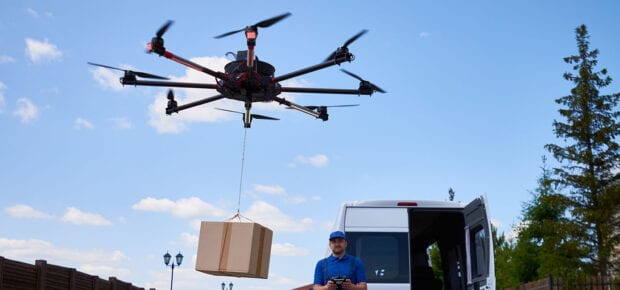November 27, 2020
COVID-19 and the increase of online shopping has many companies considering whether drone delivery may become the norm for holiday gifts and everyday deliveries. So if you’re wondering if a drone will be dropping off your holiday present this year, the reality may not be too far off. In addition to no-contact deliveries, companies see great environmental benefits in the utilization of the technology because drones are capable of using less transportation fuel to travel across town.
“Today, many companies use delivery services by bicycle or even on foot, but they can expose couriers to urban pollution and contagion in cases of a pandemic,” says IEEE Member Paulo Fernando Ferreira Rosa. “In addition, drones primarily use lithium polymer batteries, which are rechargeable and have a very low environmental impact when compared to fossil fuels.”
How Would Delivery Drones Work?
“Drones are rotary-wing aerial vehicles that can be autonomous or remotely piloted,” says Fernando Ferreira Rosa. “Recently, off-the-shelf drones have achieved a high degree of controllability and miniaturization, allowing them to perform navigation missions with dexterity in a very user-friendly interface. Drones have an important characteristic that has the ability to take off and land vertically, which makes them suitable for navigation in urban environments with obstacles and space restrictions.”
The work being done to power intelligent drones capable of maneuvering through complex city streets is only improving. According to an IEEE Spectrum article, researchers have developed an autonomous quadrotor to fly in “extreme acrobatic maneuvers with only onboard sensing and computation.”.
Learn more about deep drone acrobatics:
Algorithms have also been developed for drones to efficiently communicate with a base station or even communicate and work together with other drones to easily navigate the skies.
Are Drones Making Deliveries Now?
While many companies are hopeful and working toward implementing a logistics strategy and to gain the correct allowances within city limits to fly, it might be awhile before the package you ordered online will be dropped off by a drone.
“There are still bottlenecks for the large-scale implementation of this technological facility in modern life,” explains Fernando Ferreira Rosa.
See also Delivery Drones Could Hitchhike on Public Transit to Massively Expand Their Range
Drones and the technologists who work on them are still struggling with:
- Battery autonomy is limiting tasks to short journeys
- The payload that drones can carry
- Airspace legislation that restricts drones in urban areas
Many research and engineering groups are working to solve these problems, and some companies are already testing out drone delivery. Fernando Ferreira Rosa is hopeful that curbside drone delivery will become a common life event. “We hope that in the near future this technology will be widespread and the autonomous delivery with drones will be a daily reality.”





 Liquid Infrastructure: Our Planet's Most Precious Resource
Liquid Infrastructure: Our Planet's Most Precious Resource The Impact of Technology in 2025
The Impact of Technology in 2025 Quantum and AI: Safeguards or Threats to Cybersecurity?
Quantum and AI: Safeguards or Threats to Cybersecurity? Why AI Can't Live Without Us
Why AI Can't Live Without Us Bits, Bytes, Buildings and Bridges: Digital-Driven Infrastructure
Bits, Bytes, Buildings and Bridges: Digital-Driven Infrastructure Impact of Technology in 2024
Impact of Technology in 2024 Emerging AI Cybersecurity Challenges and Solutions
Emerging AI Cybersecurity Challenges and Solutions The Skies are Unlimited
The Skies are Unlimited Smart Cities 2030: How Tech is Reshaping Urbanscapes
Smart Cities 2030: How Tech is Reshaping Urbanscapes Impact of Technology 2023
Impact of Technology 2023 Cybersecurity for Life-Changing Innovations
Cybersecurity for Life-Changing Innovations Smarter Wearables Healthier Life
Smarter Wearables Healthier Life Infrastructure In Motion
Infrastructure In Motion The Impact of Tech in 2022 and Beyond
The Impact of Tech in 2022 and Beyond Cybersecurity, Technology and Protecting Our World
Cybersecurity, Technology and Protecting Our World How Technology Helps us Understand Our Health and Wellness
How Technology Helps us Understand Our Health and Wellness The Resilience of Humanity
The Resilience of Humanity Harnessing and Sustaining our Natural Resources
Harnessing and Sustaining our Natural Resources Creating Healthy Spaces Through Technology
Creating Healthy Spaces Through Technology Exceptional Infrastructure Challenges, Technology and Humanity
Exceptional Infrastructure Challenges, Technology and Humanity The Global Impact of IEEE's 802 Standards
The Global Impact of IEEE's 802 Standards Scenes of our Cyber Lives: The Security Threats and Technology Solutions Protecting Us
Scenes of our Cyber Lives: The Security Threats and Technology Solutions Protecting Us How Millennial Parents are Embracing Health and Wellness Technologies for Their Generation Alpha Kids
How Millennial Parents are Embracing Health and Wellness Technologies for Their Generation Alpha Kids Space Exploration, Technology and Our Lives
Space Exploration, Technology and Our Lives Global Innovation and the Environment
Global Innovation and the Environment How Technology, Privacy and Security are Changing Each Other (And Us)
How Technology, Privacy and Security are Changing Each Other (And Us) Find us in booth 31506, LVCC South Hall 3 and experience the Technology Moon Walk
Find us in booth 31506, LVCC South Hall 3 and experience the Technology Moon Walk Virtual and Mixed Reality
Virtual and Mixed Reality How Robots are Improving our Health
How Robots are Improving our Health IEEE Experts and the Robots They are Teaching
IEEE Experts and the Robots They are Teaching See how millennial parents around the world see AI impacting the lives of their tech-infused offspring
See how millennial parents around the world see AI impacting the lives of their tech-infused offspring Take the journey from farm to table and learn how IoT will help us reach the rising demand for food production
Take the journey from farm to table and learn how IoT will help us reach the rising demand for food production Watch technical experts discuss the latest cyber threats
Watch technical experts discuss the latest cyber threats Explore how researchers, teachers, explorers, healthcare and medical professionals use immersive technologies
Explore how researchers, teachers, explorers, healthcare and medical professionals use immersive technologies Follow the timeline to see how Generation AI will be impacted by technology
Follow the timeline to see how Generation AI will be impacted by technology Learn how your IoT data can be used by experiencing a day in a connected life
Learn how your IoT data can be used by experiencing a day in a connected life Listen to technical experts discuss the biggest security threats today
Listen to technical experts discuss the biggest security threats today See how tech has influenced and evolved with the Games
See how tech has influenced and evolved with the Games Enter our virtual home to explore the IoT (Internet of Things) technologies
Enter our virtual home to explore the IoT (Internet of Things) technologies Explore an interactive map showcasing exciting innovations in robotics
Explore an interactive map showcasing exciting innovations in robotics Interactively explore A.I. in recent Hollywood movies
Interactively explore A.I. in recent Hollywood movies Get immersed in technologies that will improve patients' lives
Get immersed in technologies that will improve patients' lives